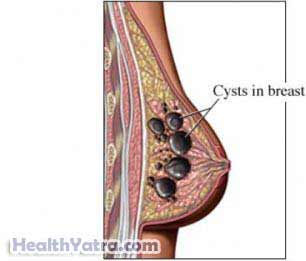Definition
MRI uses magnetic fields to make images of the inside of the body. A computer produces two- and three-dimensional pictures. MRI of the breast uses an MRI to evaluate breast tissue.

Reasons for Test
Breast MRI can be used to:
- Evaluate breast abnormalities seen on mammography
- Identify breast abnormalities in women (and in some cases, men) with dense breast tissue, implants, or scar tissue
- Examine breast implants
- Examine scar tissue
- Evaluate the progress of breast cancer treatment
- Identify cysts or enlarged breast ducts
- Examine lymph nodes near the breast
Possible Complications
MRIs can be harmful if you have metal inside your body such as joint replacements or pacemaker. Make sure your doctor knows of any internal metal before the test. Some may also have an allergic reaction to the contrast dye. Talk to your doctor about any allergies you have or if you have liver or kidney problems. These may make it difficult for your body to get rid of the contrast.
What to Expect
Prior to test
Leading up to the test:
- Try to schedule the test between days 5 and 15 of your menstrual cycle. This is a time when the breast tissue is less dense.
- If your doctor prescribes a sedative:
- Arrange for a ride home.
- Take the sedative 1-2 hours before the exam, or as directed.
Once at the MRI center:
- You will be asked about the following:
- Medical and surgical history
- Pregnancy
- Allergies
- Other conditions that you may have—If your MRI involves contrast material, your doctor will ask about the health of your kidneys. There is a risk of complications in people who have kidney disease and receive contrast material.
- You will be asked if you have something in your body that would interfere with or make it so you cannot have an MRI, such as:
- Pacemaker or implantable defibrillator
- Neurostimulator
- Ear implant
- Metal fragments in your eyes or in any other part of your body (Tell your doctor if your work involves metal filings or particles.)
- Implanted port device
- Metal plate, pins, screws, or surgical staples
- Metal clips from aneurysm repair
- Retained bullets
- Any other large metal objects in your body (Tooth fillings and braces are usually fine.)
- You will remove any metal objects (eg, jewelry, hearing aids, glasses).
- An x-ray may be taken to see if there are any metal objects in your body.
You may be:
- Given ear plugs or headphones to wear (The MRI machine makes a loud banging noise.)
- Allowed to have a family member or friend with you during the test
Description of the Test
You will lie face down on your stomach on a moveable bed. The bed will slide into a large, cylindrical magnet. Your breasts will hang into cushioned openings. You may be hooked up to monitors. These monitors will track your pulse, heart rate, and breathing. The technician will be in another room and give you directions via an intercom. A magnetic field will be produced to generate three-dimensional images of your breast tissue. As this happens, you will hear loud banging noises.
The MRI may require contrast dye to make the pictures better. In this case, you will receive an IV in your hand or arm. Contrast material will be injected through the IV.
After the Test
You will need to wait until the images are examined. In some cases, the technician may need to take more images.
- If you took a sedative, do not drive, operate machinery, or make important decisions until the sedative wears off completely.
- If you are breastfeeding and receive a contrast dye, you and your doctor should discuss when you should start breastfeeding again. Information available has not found any ill effects to a baby if a mother has had contrast dye.
How Long Will It Take?
About 1-½ hours
Will It Hurt?
No
Results
The MRI images will be sent to a radiologist. Your doctor will receive the report and talk to you about the results.
Call Your Doctor
After the test, call your doctor if any of the following occurs:
- Worsening of your symptoms
- Any allergic or abnormal symptoms, like a rash or swelling if you were injected with contrast dye
In case of an emergency, call for medical help right away.
